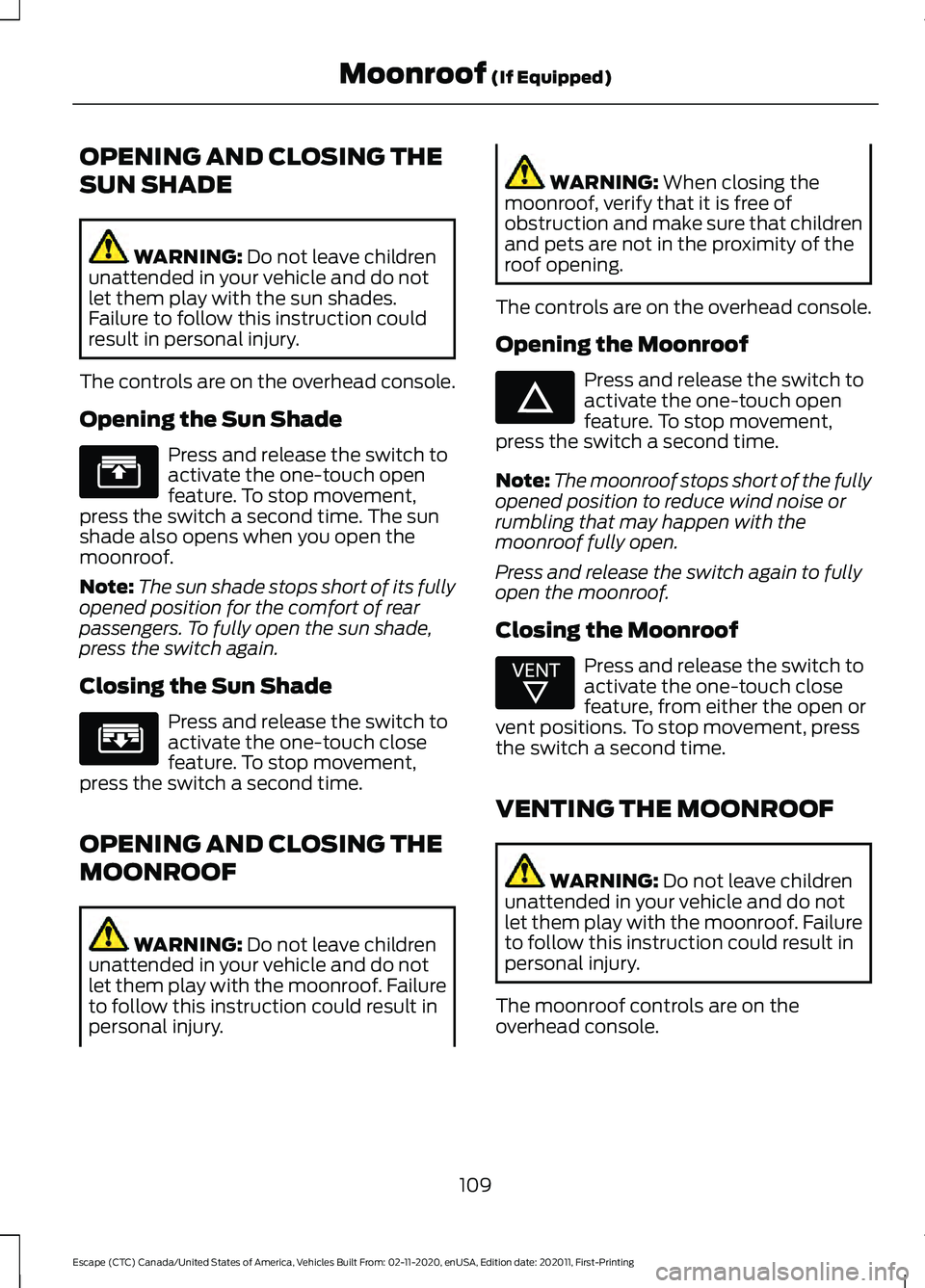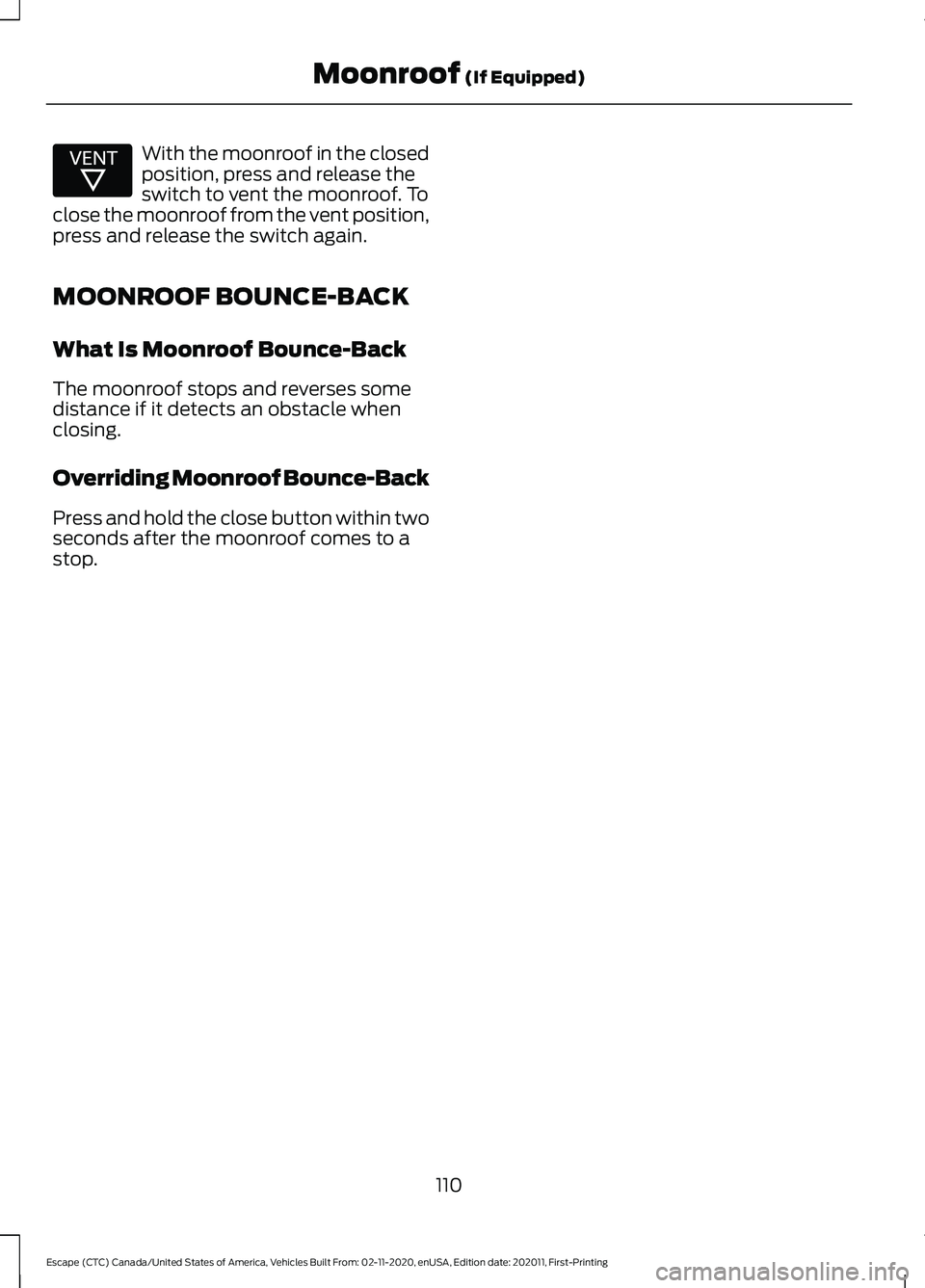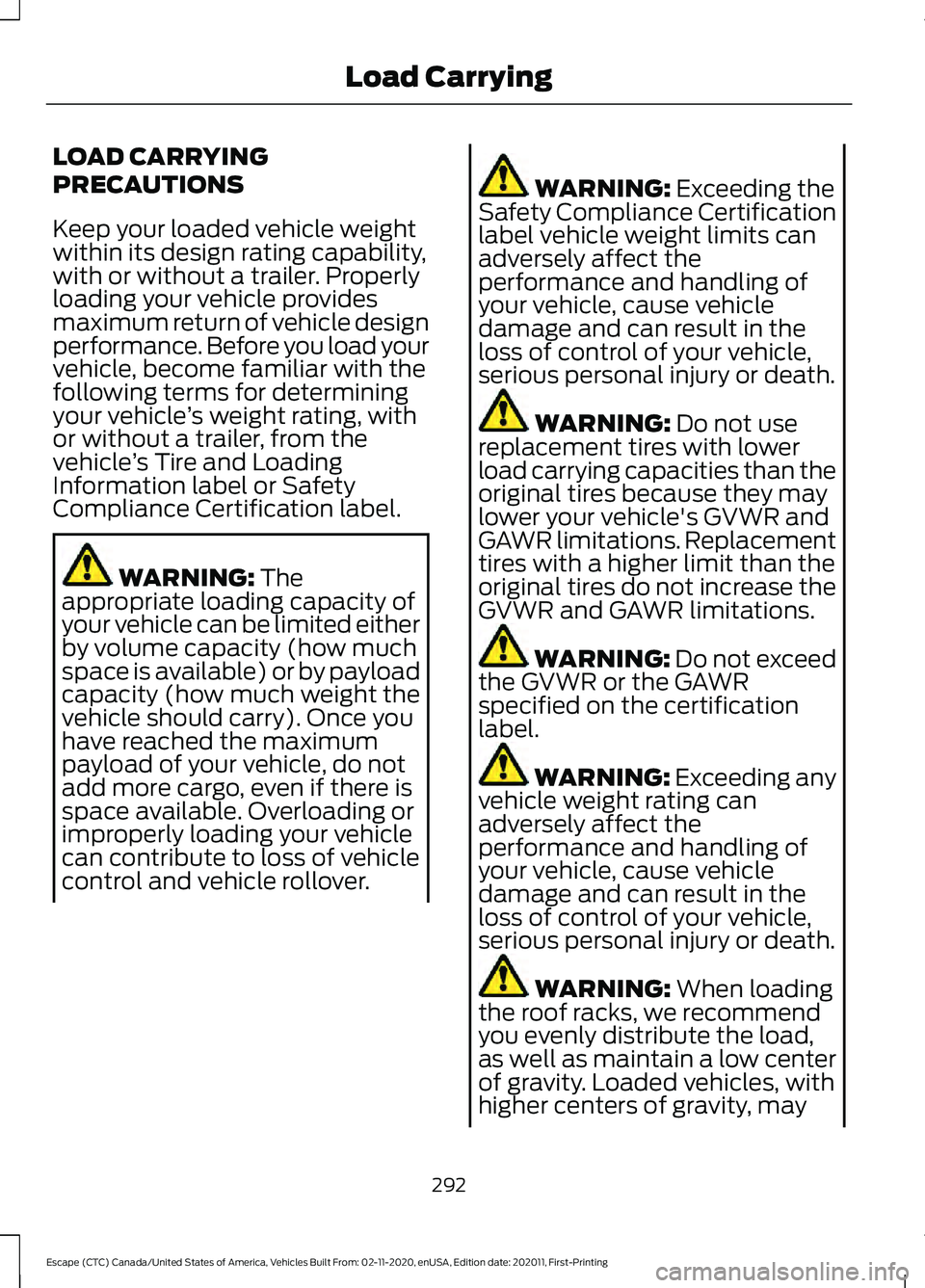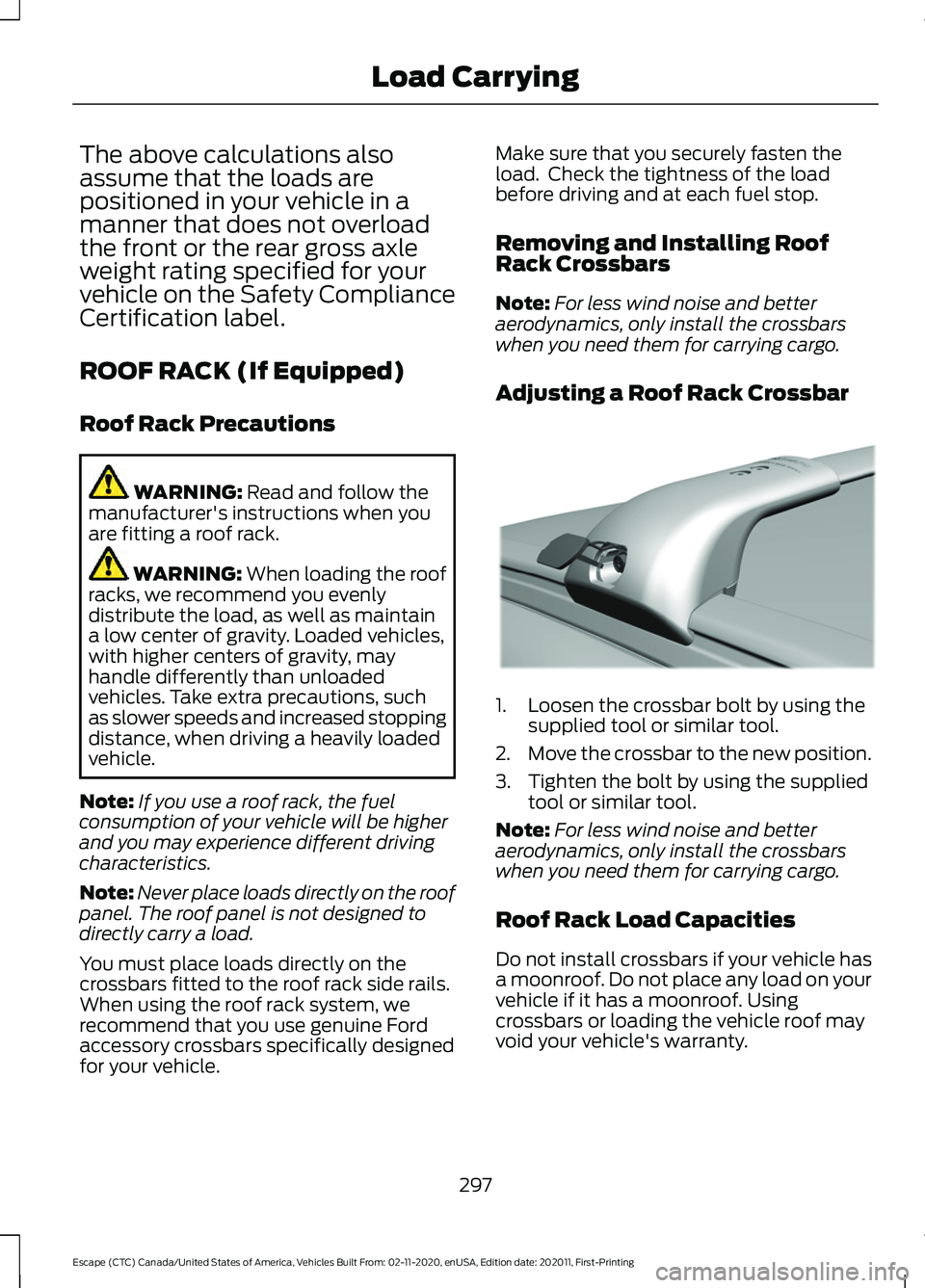2021 FORD ESCAPE roof
[x] Cancel search: roofPage 6 of 589

Switching the Rear Window Wiper On
and Off ..........................................................93
Reverse Wipe ..................................................
93
Checking the Wiper Blades .......................
94
Replacing the Front Wiper Blades .........
94
Replacing the Rear Wiper Blades ...........
94
Washers ............................................................
95
Wipers and Washers – Troubleshooting ........................................................................\
..
96
Exterior Lighting
Exterior Lighting Control .............................
97
Headlamps ......................................................
97
Headlamps – Troubleshooting ...............
98
Autolamps .......................................................
98
Exterior Lamps ...............................................
99
Automatic High Beam Control ..............
100
Automatic High Beam Control – Troubleshooting .......................................
102
Interior Lighting
Switching All of the Interior Lamps On and Off ........................................................
103
Switching the Front Interior Lamps On and Off ........................................................
103
Switching the Rear Interior Lamps On and Off ........................................................
103
Interior Lamp Function ..............................
103
Adjusting the Instrument Panel Lighting Brightness ..................................................
103
Ambient Lighting .........................................
103
Interior Lighting – Troubleshooting ......
104
Windows
Opening and Closing the Windows ......
105
Window Bounce-Back ..............................
105
Locking the Rear Window Controls ......
106
Interior Mirror
Interior Mirror Precautions ........................
107Manually Dimming the Interior Mirror
........................................................................\
.
107
Auto-Dimming Interior Mirror ..................
107
Exterior Mirrors
Adjusting the Exterior Mirrors .................
108
Folding the Exterior Mirrors .....................
108
Moonroof
Opening and Closing the Sun Shade ........................................................................\
109
Opening and Closing the Moonroof ......
109
Venting the Moonroof ...............................
109
Moonroof Bounce-Back ............................
110
Instrument Cluster
Instrument Cluster Overview - Gasoline, Vehicles With: 4.2 Inch Instrument
Cluster Display Screen .............................
111
Instrument Cluster Overview - Gasoline, Vehicles With: 6.5 Inch Instrument
Cluster Display Screen ............................
112
Instrument Cluster Overview - Gasoline, Vehicles With: 12.3 Inch Instrument
Cluster Display Screen ............................
113
Instrument Cluster Overview - Hybrid Electric Vehicle (HEV), Vehicles With:
6.5 Inch Instrument Cluster Display
Screen ...........................................................
114
Instrument Cluster Overview - Hybrid Electric Vehicle (HEV), Vehicles With:
12.3 Inch Instrument Cluster Display
Screen ...........................................................
115
Instrument Cluster Overview - Plug-In Hybrid Electric Vehicle (PHEV),
Vehicles With: 6.5 Inch Instrument
Cluster Display Screen ...........................
116
Instrument Cluster Overview - Plug-In Hybrid Electric Vehicle (PHEV),
Vehicles With: 12.3 Inch Instrument
Cluster Display Screen ............................
117
What Is the Tachometer - Excluding: Hybrid Electric Vehicle (HEV)/Plug-In
Hybrid Electric Vehicle (PHEV) ...........
117
3
Escape (CTC) Canada/United States of America, Vehicles Built From: 02-11-2020, enUSA, Edition date: 202011, First-Printing Table of Contents
Page 13 of 589

Locating the Pre-Collision Assist Sensors
........................................................................\
.281
Distance Indication .....................................
281
Distance Alert ..............................................
283
Automatic Emergency Braking ..............
283
Evasive Steering Assist .............................
284
Pre-Collision Assist – Troubleshooting ........................................................................\
285
Driver Alert
What Is Driver Alert ....................................
287
How Does Driver Alert Work ...................
287
Driver Alert Precautions ............................
287
Driver Alert Limitations .............................
287
Switching Driver Alert On and Off ........
287
Driver Alert Indicators ...............................
288
Driver Alert – Troubleshooting ..............
288
Speed Sign Recognition
What Is Speed Sign Recognition ..........
289
How Does Speed Sign Recognition Work ........................................................................\
289
Speed Sign Recognition Precautions ........................................................................\
289
Speed Sign Recognition Limitations ........................................................................\
289
Speed Sign Recognition Indicators ......
289
Setting the Speed Sign Recognition Speed Warning .......................................
290
Setting the Speed Sign Recognition Speed Tolerance ....................................
290
Speed Sign Recognition – Troubleshooting .....................................
290
Load Carrying
Load Carrying Precautions ......................
292
Locating the Safety Compliance Certification Labels ...............................
293
What Is the Gross Axle Weight Rating ........................................................................\
293
What Is the Gross Vehicle Weight Rating ........................................................................\
293 What Is the Gross Combined Weight
Rating ..........................................................
293
Calculating Payload ...................................
295
Calculating the Load Limit ......................
295
Roof Rack .......................................................
297
Luggage Compartment
Installing and Removing the Luggage Compartment Cover .............................
299
Connecting a Trailer
Connecting a Trailer Precautions ..........
301
Connecting a Trailer ...................................
301
Towing a Trailer
Towing a Trailer Precautions ..................
303
Trailer Brake Precautions ........................
303
Towing a Trailer Limitations ...................
304
Loading Your Trailer ...................................
304
Trailer Towing Hints ...................................
304
Launching or Retrieving a Boat or Personal Watercraft ..............................
305
Towing Weights and Dimensions ........
306
Trailer Sway Control
How Does Trailer Sway Control Work ........................................................................\
.
310
Trailer Sway Control Precautions ..........
310
Switching Trailer Sway Control On and Off .................................................................
310
Driving Hints
Cold Weather Precautions ........................
311
Breaking-In ......................................................
311
Driving Economically ...................................
311
Driving Through Shallow Water ..............
311
Floor Mats .......................................................
312
Crash and Breakdown Information
Roadside Assistance ..................................
313
10
Escape (CTC) Canada/United States of America, Vehicles Built From: 02-11-2020, enUSA, Edition date: 202011, First-Printing Table of Contents
Page 52 of 589

The Safety Canopy deploys during
significant side crashes or when a certain
likelihood of a rollover event is detected
by the rollover sensor. The Safety Canopy
is mounted to the roof side-rail sheet
metal, behind the headliner, above each
row of seats. In certain sideways crashes
or rollover events, the Safety Canopy will
be activated, regardless of which seats are
occupied. The Safety Canopy inflates
between the side window area and
occupants to further enhance protection
provided in side impact crashes and
rollover events.
The system consists of the following:
•
Safety Canopy curtain airbags above
the trim panels over the front and rear
side windows identified by a label or
wording on the headliner or roof-pillar
trim.
• A flexible headliner which opens above
the side doors to allow air curtain
deployment · Crash sensors and monitoring
system with a readiness
indicator. See Crash Sensors
and Airbag Indicator (page 54). Properly restrain children 12 years old and
under in the rear seats. The Safety Canopy
will not interfere with children restrained
using a properly installed child or booster
seat because it is designed to inflate
downward from the headliner above the
doors along the side window opening.
AIRBAG PRECAUTIONS
WARNING:
Airbags do not inflate
slowly or gently, and the risk of injury
from a deploying airbag is the greatest
close to the trim covering the airbag
module. WARNING:
All occupants of your
vehicle, including the driver, should
always properly wear their seatbelts,
even when an airbag supplemental
restraint system is provided. Failure to
properly wear your seatbelt could
seriously increase the risk of injury or
death. WARNING:
Properly secure
children 12 years old and under in a rear
seating position whenever possible. If
you are unable to properly secure all
children in a rear seating position,
properly secure the largest child on the
front seat. If you must use a forward
facing child restraint on the front seat,
move the seat as far back as possible.
Failure to follow these instructions could
result in personal injury or death. WARNING:
Do not place your arms
on the airbag cover or through the
steering wheel. Failure to follow this
instruction could result in personal injury.
49
Escape (CTC) Canada/United States of America, Vehicles Built From: 02-11-2020, enUSA, Edition date: 202011, First-Printing Airbags E75004 E67017
Page 112 of 589

OPENING AND CLOSING THE
SUN SHADE
WARNING: Do not leave children
unattended in your vehicle and do not
let them play with the sun shades.
Failure to follow this instruction could
result in personal injury.
The controls are on the overhead console.
Opening the Sun Shade Press and release the switch to
activate the one-touch open
feature. To stop movement,
press the switch a second time. The sun
shade also opens when you open the
moonroof.
Note: The sun shade stops short of its fully
opened position for the comfort of rear
passengers. To fully open the sun shade,
press the switch again.
Closing the Sun Shade Press and release the switch to
activate the one-touch close
feature. To stop movement,
press the switch a second time.
OPENING AND CLOSING THE
MOONROOF WARNING:
Do not leave children
unattended in your vehicle and do not
let them play with the moonroof. Failure
to follow this instruction could result in
personal injury. WARNING:
When closing the
moonroof, verify that it is free of
obstruction and make sure that children
and pets are not in the proximity of the
roof opening.
The controls are on the overhead console.
Opening the Moonroof Press and release the switch to
activate the one-touch open
feature. To stop movement,
press the switch a second time.
Note: The moonroof stops short of the fully
opened position to reduce wind noise or
rumbling that may happen with the
moonroof fully open.
Press and release the switch again to fully
open the moonroof.
Closing the Moonroof Press and release the switch to
activate the one-touch close
feature, from either the open or
vent positions. To stop movement, press
the switch a second time.
VENTING THE MOONROOF WARNING:
Do not leave children
unattended in your vehicle and do not
let them play with the moonroof. Failure
to follow this instruction could result in
personal injury.
The moonroof controls are on the
overhead console.
109
Escape (CTC) Canada/United States of America, Vehicles Built From: 02-11-2020, enUSA, Edition date: 202011, First-Printing Moonroof
(If Equipped)E312249 E312250 E312251 E312252
Page 113 of 589

With the moonroof in the closed
position, press and release the
switch to vent the moonroof. To
close the moonroof from the vent position,
press and release the switch again.
MOONROOF BOUNCE-BACK
What Is Moonroof Bounce-Back
The moonroof stops and reverses some
distance if it detects an obstacle when
closing.
Overriding Moonroof Bounce-Back
Press and hold the close button within two
seconds after the moonroof comes to a
stop.
110
Escape (CTC) Canada/United States of America, Vehicles Built From: 02-11-2020, enUSA, Edition date: 202011, First-Printing Moonroof (If Equipped)E312252
Page 234 of 589

HOW DOES STABILITY
CONTROL WORK
WARNING: Vehicle modifications
involving braking system, aftermarket
roof racks, suspension, steering system,
tire construction and wheel and tire size
may change the handling characteristics
of your vehicle and may adversely affect
the performance of the electronic
stability control system. In addition,
installing any stereo loudspeakers may
interfere with and adversely affect the
electronic stability control system. Install
any aftermarket stereo loudspeaker as
far as possible from the front center
console, the tunnel, and the front seats
in order to minimize the risk of interfering
with the electronic stability control
sensors. Reducing the effectiveness of
the electronic stability control system
could lead to an increased risk of loss of
vehicle control, vehicle rollover, personal
injury and death. WARNING:
Remember that even
advanced technology cannot defy the
laws of physics. It's always possible to
lose control of a vehicle due to
inappropriate driver input for the
conditions. Aggressive driving on any
road condition can cause you to lose
control of your vehicle increasing the risk
of personal injury or property damage.
Activation of the electronic stability
control system is an indication that at
least some of the tires have exceeded
their ability to grip the road; this could
reduce the operator's ability to control
the vehicle potentially resulting in a loss
of vehicle control, vehicle rollover,
personal injury and death. If your
electronic stability control system
activates, SLOW DOWN. If a driving condition activates either the
stability control or the traction control
system you may experience the following
conditions:
•
The stability and traction control light
flashes.
• Your vehicle slows down.
• Reduced engine power.
The stability control system has several
features built into it to help you maintain
control of your vehicle:
Electronic Stability Control
Electronic stability control enhances your
vehicle ’s ability to prevent skids or lateral
slides by applying brakes to one or more
of the wheels individually and, if necessary,
reducing engine power.
Roll Stability Control
Roll stability control enhances your
vehicle ’s ability to prevent rollovers by
detecting your vehicle ’s roll motion and
the rate at which it changes by applying
the brakes to one or more wheels
individually.
Curve Control
Curve control enhances your vehicle ’s
ability to follow the road when cornering
severely or avoiding objects in the roadway.
Curve control operates by reducing engine
power and, if necessary, applying brakes
to one or more of the wheels individually.
Traction Control
Traction control enhances your vehicle ’s
ability to maintain traction of the wheels
by detecting and controlling wheel spin.
See
How Does Traction Control Work
(page 229).
231
Escape (CTC) Canada/United States of America, Vehicles Built From: 02-11-2020, enUSA, Edition date: 202011, First-Printing Stability Control
Page 295 of 589

LOAD CARRYING
PRECAUTIONS
Keep your loaded vehicle weight
within its design rating capability,
with or without a trailer. Properly
loading your vehicle provides
maximum return of vehicle design
performance. Before you load your
vehicle, become familiar with the
following terms for determining
your vehicle
’s weight rating, with
or without a trailer, from the
vehicle ’s Tire and Loading
Information label or Safety
Compliance Certification label. WARNING: The
appropriate loading capacity of
your vehicle can be limited either
by volume capacity (how much
space is available) or by payload
capacity (how much weight the
vehicle should carry). Once you
have reached the maximum
payload of your vehicle, do not
add more cargo, even if there is
space available. Overloading or
improperly loading your vehicle
can contribute to loss of vehicle
control and vehicle rollover. WARNING:
Exceeding the
Safety Compliance Certification
label vehicle weight limits can
adversely affect the
performance and handling of
your vehicle, cause vehicle
damage and can result in the
loss of control of your vehicle,
serious personal injury or death. WARNING:
Do not use
replacement tires with lower
load carrying capacities than the
original tires because they may
lower your vehicle's GVWR and
GAWR limitations. Replacement
tires with a higher limit than the
original tires do not increase the
GVWR and GAWR limitations. WARNING:
Do not exceed
the GVWR or the GAWR
specified on the certification
label. WARNING: Exceeding any
vehicle weight rating can
adversely affect the
performance and handling of
your vehicle, cause vehicle
damage and can result in the
loss of control of your vehicle,
serious personal injury or death. WARNING:
When loading
the roof racks, we recommend
you evenly distribute the load,
as well as maintain a low center
of gravity. Loaded vehicles, with
higher centers of gravity, may
292
Escape (CTC) Canada/United States of America, Vehicles Built From: 02-11-2020, enUSA, Edition date: 202011, First-Printing Load Carrying
Page 300 of 589

The above calculations also
assume that the loads are
positioned in your vehicle in a
manner that does not overload
the front or the rear gross axle
weight rating specified for your
vehicle on the Safety Compliance
Certification label.
ROOF RACK (If Equipped)
Roof Rack Precautions
WARNING: Read and follow the
manufacturer's instructions when you
are fitting a roof rack. WARNING:
When loading the roof
racks, we recommend you evenly
distribute the load, as well as maintain
a low center of gravity. Loaded vehicles,
with higher centers of gravity, may
handle differently than unloaded
vehicles. Take extra precautions, such
as slower speeds and increased stopping
distance, when driving a heavily loaded
vehicle.
Note: If you use a roof rack, the fuel
consumption of your vehicle will be higher
and you may experience different driving
characteristics.
Note: Never place loads directly on the roof
panel. The roof panel is not designed to
directly carry a load.
You must place loads directly on the
crossbars fitted to the roof rack side rails.
When using the roof rack system, we
recommend that you use genuine Ford
accessory crossbars specifically designed
for your vehicle. Make sure that you securely fasten the
load. Check the tightness of the load
before driving and at each fuel stop.
Removing and Installing Roof
Rack Crossbars
Note:
For less wind noise and better
aerodynamics, only install the crossbars
when you need them for carrying cargo.
Adjusting a Roof Rack Crossbar 1. Loosen the crossbar bolt by using the
supplied tool or similar tool.
2. Move the crossbar to the new position.
3. Tighten the bolt by using the supplied tool or similar tool.
Note: For less wind noise and better
aerodynamics, only install the crossbars
when you need them for carrying cargo.
Roof Rack Load Capacities
Do not install crossbars if your vehicle has
a moonroof. Do not place any load on your
vehicle if it has a moonroof. Using
crossbars or loading the vehicle roof may
void your vehicle's warranty.
297
Escape (CTC) Canada/United States of America, Vehicles Built From: 02-11-2020, enUSA, Edition date: 202011, First-Printing Load CarryingE299329